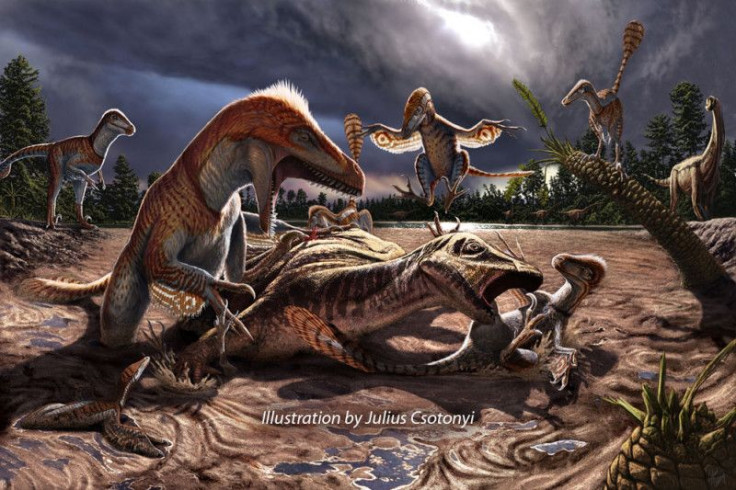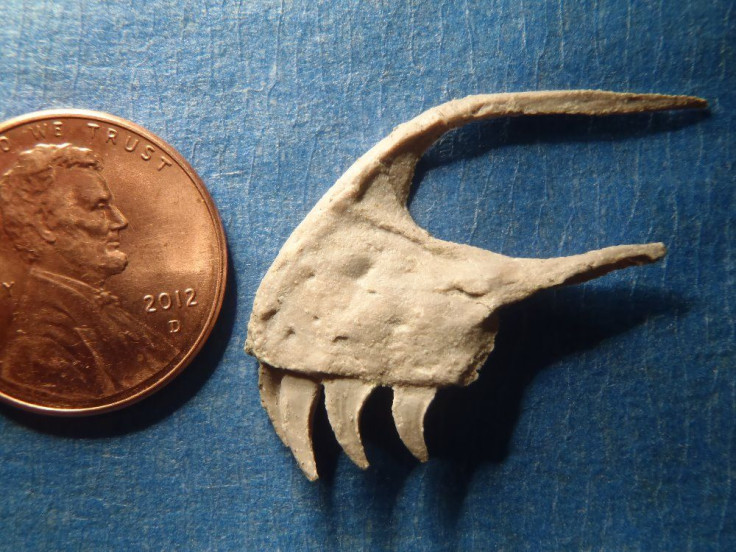Paleontologists Need Help Opening Utah Quicksand Tomb Filled With Raptors

Millions of years ago, a bunch of raptors saw a delicious feast and chased it directly into a stretch of quicksand, killing themselves and entombing their remains in what eventually transformed into a giant block of sandstone sticking out of a hillside in Utah. Today, scientists are asking for public help so they can slowly chip away at the stone and expose the fossils suspended inside.
It’s no small task because it’s such a small task. Scott Madsen, who specializes in this sort of fossil preparation, told International Business Times that the Utahraptor dinosaurs trapped in the sandstone range from adults the size of a full-grown human to babies that are roughly the size of a chicken. They are perhaps all in there together because they were hunting as a family or in a pack. He and his colleagues are “looking at some very small, delicate bones,” many of which have been “shattered in place.”
“It has to be removed very, very carefully, so you’re exposing a few millimeters of bone surfaces at a time,” Madsen explained. You can’t even “blow too hard or…pieces will be lost forever.”
He does a lot of his work with a microscope. That means his attention is focused on one tiny spot at a time, while the entire chunk of sandstone is 18,000 pounds. It’s 10 feet long, 8 feet across and 3 feet thick, Madsen said, “bigger than a king-sized bed.”
But inside that rock is a treasure trove of information about the dinosaurs that are similar to what people classically picture when they think about raptors — specifically, the velociraptors that terrorize the human characters in the “Jurassic Park” movies. The scientists want to remove and study the bones to better understand the dinosaurs but with institutional funds lacking due to budget constraints, they have set up a GoFundMe page to ask the public for assistance.
Utahraptors were first discovered in the early 1990s but paleontologists were only able to describe them based on a few bones, similar to a claw. According to the Utahraptor Project, they were about 18 feet long and sported feathered bodies and “huge sickle claws on their second toes, with the largest specimen measuring 8.7 inches long.” They lived about 124 million years ago, during the early Cretaceous period.
For comparison, velociraptors were about half as big.
“It’s a velociraptor on steroids,” Madsen told IBT. “It’s a much more heavily built dinosaur.”

It’s possible that while the scientists are doing their work on this sandstone block that they will find more than just Utahraptors. According to Madsen, there might be other predators in there that fell into the same quicksand trap as their companions, seeing “what they thought was a good free meal” stuck in muck and getting mired themselves while going in for the kill.
“It’s kind of this confusing tangle of bone,” he said, and the paleontologists have to pick apart the pieces to figure out what happened all those millions of years ago, when the dinosaurs became trapped.
Madsen compared the sandstone block to the La Brea Tar Pits in Los Angeles. They are a hotspot for fossils that take their name from the viscous pools of crude oil that bubble up to the surface from an underground petroleum source, sometimes carrying with them ancient bones and artifacts. A lot of animals and insects would have gotten trapped inside the liquid asphalt in warm weather, when the pools were super sticky and acted like quicksand. If they weren’t eaten by predators, they would have died of exhaustion while trying in vain to escape. The tar pits then preserved their remains for thousands of years.
To get at the Utahraptor fossils that are trapped in the sandstone block will take perhaps five years, according to Madsen. He plans to use high-tech imaging as he goes, giving scientists and the public a 3D reconstruction of the sandstone block and the fossils inside. Knowing where the different bones sat in the stone before they were meticulously removed will help the experts put together the picture of how they got there in the first place.

And offering this view to the public will help the experts use the project as an educational tool and to get people interested in science.
So far he has microscope equipment to get started, but the team still needs funding for salaries, among other needs. Madsen said the GoFundMe funds will cover his pay for the project — “as a full-time job … people need to be paid for this kind of thing” — and he hopes to have enough money to train another person to do his sort of specialized microscopic fossil preparation work, to get another pair of hands.
It will take time: “We’ve barely skimmed the surface,” he said.
According to Jim Kirkland, the state paleontologist at the Utah Geological Survey and one of the first to discover and describe the Utahraptor, it will take years “to extract the fossils and the data from this massive block.” With the smallest bones, from the baby Utahraptors, for example, the work is akin to “preparing eggshells out of concrete — think of that.”
“We need to go after this full-time,” he said. “I want to live long enough to know at least a portion of what we may glean from this amazing fossil, the most important thing that I ever took part in collecting.”
© Copyright IBTimes 2024. All rights reserved.











